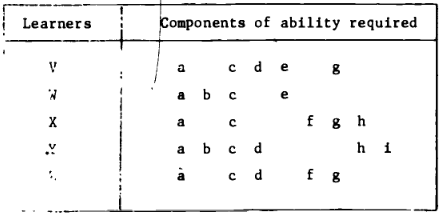Unit/Credit system
The promotion of efficient learning is a major aim of educational systems. If learning is to be truly efficient learners must be enabled to satisfy their own individual learning-needs in the most direct way possible.
Individual learners’ needs will vary widely. It is perhaps no exaggeration to say that each individual learner has his own needs, which are different from those of any other learner. Yet, organised education can only cater for the individual learner if he can be grouped with other learners to form a sufficiently large class to justify the investment of efforts and finance required to satisfy his needs. How to reconcile the variety of individual learners’ needs with an economical use of available resources is one of the main problems in educational planning.
Let us suppose we have to provide instruction for five learners, V, W, X, Y and Z, who have each of the different needs. We cannot afford to run five separate courses directly geared towards each individual’s needs.
In order to solve our problem we first analyse the ability required by each learner into components:
One way of organising a teaching-syllabus would be to set up a course containing all the elements a – i, thus fully satisfying the needs of each learner. However, it could mean that each learner would have to learn much more than he actually needs. Consequently, the syllabus would be uneconomical.
Alternatively, we might provide a course containing only those components which are needed by all the learners, namely a and c. This would be highly economical, but it would leave each learner’s needs partly unsatisfied.
A more satisfactory approach than either of the above alternatives, and still economically viable if used on a sufficiently large scale, would be to cater for our learners in groups of varying composition. This would mean providing a course in components a and c for all five of them, one in component d for V, Y, and Z, one in e for V and W etc etc. Component i appears to be needed only by learner Y, so we would try to find other learners, outside our group, who share this need, so as to justify providing a course for it.
In addition to analysing the needs of each learner and providing learning-facilities for each component, we would have to advise the learner on the order in which the various components could be taken most profitably.
We would tell him, for instance, whether component h could be tackled right at the start, or only after a and c have been mastered, or after a but simultaneously with c, etc etc.
A unit-system is a learning-system designed to cater for individual learners in the way described last. It breaks down a global learning-task, such as learning mathematics or learning a language, into portions, or units, each of which correspond to a component of a learner’s needs and is systematically related to all the other portions.
Once such a system has been developed and implemented, each learner can be advised as to which units to take and in which order. If the system is used on a large scale, e.g. on a European scale, the demand for the majority of the components is likely to be large enough to justify the provision of learning-facilities for the development.
If, after successfully completing a unit, or a group of units, the learners are given some sort of official recognition for their achievement, the system is a unit credit system.
Each portion, or unit, in our learning-system has to be described clearly and learners will have to know what it is they are advised to learn and those responsible for providing learning-facilities will need a clear view of what is expected of them.
Since each unit corresponds to a learner’s need, or a component of a learner’s need, the most direct way of describing it most directly related to need-fulfilment is a statement of what the learner will be able to do after successfully completing a unit. This gives the essential information both to the learner and to the teachers’ course-designers, etc, whilst leaving full scope for the use of a variety of teaching techniques, course materials, etc to be chosen in accordance with the special circumstances of each type of learner.
What the learner will be able to do after completing a unit, is called the learning-objective of that unit. In order to serve its purpose adequately, the description of a learning-objective must be as explicit as possible. This means that a learning-objective must be defined in such a way that it unambiguously means one and the same thing to anyone for whom it is meant.
In a unit/credit system the various objectives should, moreover, be defined in such a way that they themselves form an integrated system. This means that one single model, one and the same set of defining-principles, should be used for the definition of all the objectives throughout the unit/credit system. Only when this condition is fulfilled can the inter-relations between the various objectives be clearly perceived. Only then will it be possible to state unambiguously whether objectives are at different levels, or at the same level but of different types. Only then can we establish, in accordance with individual learners’ needs and prior competence, recommended orders of progress through the unit/credit system.
To sum up: the establishment of a unit/credit system requires the following steps:
- investigating and analysing learners’ needs;
- grouping learners into categories with similar needs;
- defining learning-objectives to meet the needs of each category in such a way as to form an integrated system of objectives;
- providing learning-facilities so as to enable learners to reach XXX various objectives in the most direct way possible.
Reference: Council for cultural cooperation.

